story and photos by Kayte Deioma
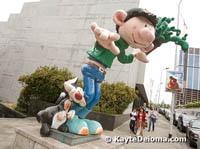 There’s something irresistible about a city as devoted to comic strips as Brussels. There are no less than four museums devoted to the history, the creators and the production of the bande dessinée or comic strip. There are over a dozen stores specializing in comic books and merchandise, and even a comic-themed bar. As if that weren’t enough, you can see larger than life comic statues and murals of some of the most popular characters all around town.
There’s something irresistible about a city as devoted to comic strips as Brussels. There are no less than four museums devoted to the history, the creators and the production of the bande dessinée or comic strip. There are over a dozen stores specializing in comic books and merchandise, and even a comic-themed bar. As if that weren’t enough, you can see larger than life comic statues and murals of some of the most popular characters all around town.
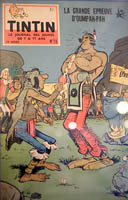 It’s not the American classics like Peanuts and Superman, or Japanese animé, but home-grown creations like Tintin, the Smurfs and hundreds of others that have filled the pages of Belgian newspapers, magazines and comic books for a century. Belgium, as it turns out, has more comic strip authors per square mile than anywhere else in the world.
It’s not the American classics like Peanuts and Superman, or Japanese animé, but home-grown creations like Tintin, the Smurfs and hundreds of others that have filled the pages of Belgian newspapers, magazines and comic books for a century. Belgium, as it turns out, has more comic strip authors per square mile than anywhere else in the world.
Your jumping off point for exploring the Belgian passion for comics should be the Centre Belge de la Bande Dessinée, the Belgian Center for Comic Strip Art. The museum opened in 1989 in an Art Nouveau warehouse designed by the famed architect Victor Horta. The museum has taken on the secondary mission of providing information on Belgian Art Nouveau with a dedicated gallery on the entry level, next to the Horta Brasserie and Restaurant.
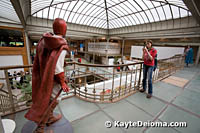 The strategically placed comic strip characters look a bit out of place in the elegant lobby with its stone columns and wrought iron grillwork supporting a frosted glass ceiling embellished with stained glass ribbons around the edges. Through an opening in the center you can see the upper floors and skylight above. Along with the restaurant and Art Nouveau gallery, a gift shop, reading room and research center surround the atrium. A marble-based lamp post stands in the center, and a wide stairway leads up to the ticket desk and official entrance to the museum.
The strategically placed comic strip characters look a bit out of place in the elegant lobby with its stone columns and wrought iron grillwork supporting a frosted glass ceiling embellished with stained glass ribbons around the edges. Through an opening in the center you can see the upper floors and skylight above. Along with the restaurant and Art Nouveau gallery, a gift shop, reading room and research center surround the atrium. A marble-based lamp post stands in the center, and a wide stairway leads up to the ticket desk and official entrance to the museum.
Although some of the temporary exhibits include English captions, the permanent displays usually do not. If you don’t speak French or Dutch, you’ll want to ask for the printed English Guide to carry along with you, or call ahead to hire an English speaking tour guide.
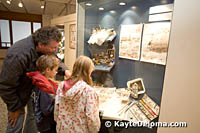 The first hall behind the ticket counter introduces you to the original technologies used to create and print comic strips as well as the team of writers, artists, colorists, letterers and printers whose efforts go into producing the final product. Publishers, marketers and merchandisers have their roles as well.
The first hall behind the ticket counter introduces you to the original technologies used to create and print comic strips as well as the team of writers, artists, colorists, letterers and printers whose efforts go into producing the final product. Publishers, marketers and merchandisers have their roles as well.
You are taken through the process with examples of each stage of production. Paper, pencils, pens, watercolors, paint brushes, felt-tip markers, and drawing templates initiate you to the tools of the trade. A story board with inky cat paw prints and crumpled rejected pages on the floor take you into the artists’ studio.
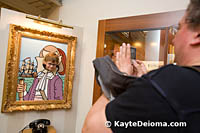 In the Espace Saint Roche gallery, the museum presents rotating exhibits from their collection of over 7,000 original comic strip drawings. On the opposite side, Comic Strips in Motion shows the evolution from comic strips to animated cartoons from Little Nemo, the first animated cartoon in 1911, to modern digital animation technology.
In the Espace Saint Roche gallery, the museum presents rotating exhibits from their collection of over 7,000 original comic strip drawings. On the opposite side, Comic Strips in Motion shows the evolution from comic strips to animated cartoons from Little Nemo, the first animated cartoon in 1911, to modern digital animation technology.
On the second level you meet the pioneers of Belgian comics through 1960 including the country’s most famous bande dessinée creator Hergé (Georges Remi), creator of Tintin. The intrepid journalist’s adventures have been translated and published around the world since 1929. The series has been made into many animated episodes, and Steven Spielberg recently bought the rights to make a Tintin movie.
Additional presentations highlight the contribution of each artist, scriptwriter and publisher to the evolution of French and Dutch language comic strips, comic strip magazines and comic books in Belgium.
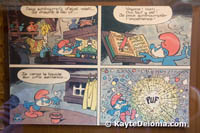 The Smurf Museum exhibit tells the tale of the “intrepid Professor De Saeger” who found the mystical land of the little blue “Schtroumphs” and brought back these artifacts to prove their existence. The display includes original line drawings and paints and well as Smurf toys and a “scale model of a Smurf dwelling.”
The Smurf Museum exhibit tells the tale of the “intrepid Professor De Saeger” who found the mystical land of the little blue “Schtroumphs” and brought back these artifacts to prove their existence. The display includes original line drawings and paints and well as Smurf toys and a “scale model of a Smurf dwelling.”
Interesting temporary shows bring an international perspective into the otherwise Belgian-focused museum. The touring exhibits are more likely to have English captions as well. In summer 2008, the museum will be celebrating the 50th anniversary of the Smurfs with a special exhibition.
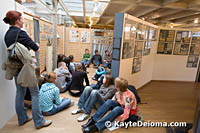 The printed English guide is invaluable for understanding the significance of the permanent collection if you don’t read French or Dutch. If you want to get the most out of the museum but you don’t want to do all that reading, you might want to hire an English-speaking guide. They are available by appointment only and charge a flat rate for up to 25 people for a one and a half hour tour. Guides are also available to take you on a walking tour of the outdoor Comic Strip Trail.
The printed English guide is invaluable for understanding the significance of the permanent collection if you don’t read French or Dutch. If you want to get the most out of the museum but you don’t want to do all that reading, you might want to hire an English-speaking guide. They are available by appointment only and charge a flat rate for up to 25 people for a one and a half hour tour. Guides are also available to take you on a walking tour of the outdoor Comic Strip Trail.
The Belgian Comic Strip Center
20 rue des Sables – 1000 Brussels
Open every day (except Monday) from 10 am to 6 pm
www.comicscentre.net
Phone: 32 (0) 2 219 19 80
Email: visit@comicscentre.net
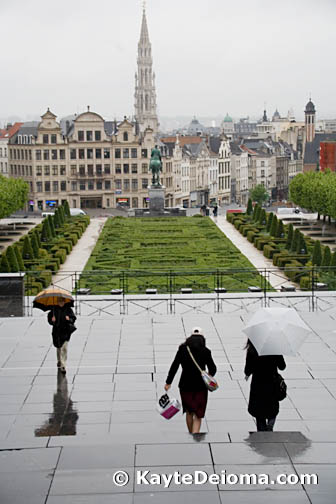

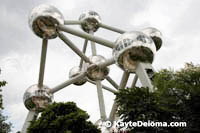 One of Brussels’ most striking landmarks is the Atomium, a giant iron atom that towers over the Heysel Plateu. The 390 foot structure, designed by engineer André Waterkyn, was built for the 1958 International Exposition of Brussels. Like the Eiffel Tower, it was planned as a temporary attraction, but due to popular demand, became a permanent part of the Brussels landscape. A recent renovation, completed in 2006, restored the steel globes to their original splendor.
One of Brussels’ most striking landmarks is the Atomium, a giant iron atom that towers over the Heysel Plateu. The 390 foot structure, designed by engineer André Waterkyn, was built for the 1958 International Exposition of Brussels. Like the Eiffel Tower, it was planned as a temporary attraction, but due to popular demand, became a permanent part of the Brussels landscape. A recent renovation, completed in 2006, restored the steel globes to their original splendor.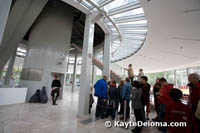 is the structure itself. From an architectural and engineering standpoint, as well as from a purely aesthetic view, to put it in sophisticated terms, it’s really cool!
is the structure itself. From an architectural and engineering standpoint, as well as from a purely aesthetic view, to put it in sophisticated terms, it’s really cool!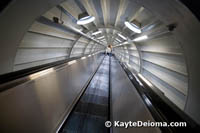 There are nine spheres connected by 20 tubes. There’s an elevator straight up the middle which will take you to the snack bar in the middle sphere and the casual restaurant at the top. Each tube is only wide enough for either one escalator or a staircase, so to visit the side globes, you follow the escalators up, and take the stairs back down the other side.
There are nine spheres connected by 20 tubes. There’s an elevator straight up the middle which will take you to the snack bar in the middle sphere and the casual restaurant at the top. Each tube is only wide enough for either one escalator or a staircase, so to visit the side globes, you follow the escalators up, and take the stairs back down the other side.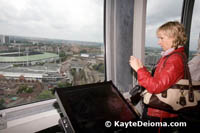 You start your visit by taking the elevator to the top to check out the panoramic view over the neighboring Mini-Europe at the Bruparck to the alternating old and new neighborhoods and stretches of green parks that make up greater Brussels. The observation floor and the restaurant above it are in the only globe with windows giving you the 360 degree panoramic view. Interactive monitors help to orient you to what you are seeing in the distance.
You start your visit by taking the elevator to the top to check out the panoramic view over the neighboring Mini-Europe at the Bruparck to the alternating old and new neighborhoods and stretches of green parks that make up greater Brussels. The observation floor and the restaurant above it are in the only globe with windows giving you the 360 degree panoramic view. Interactive monitors help to orient you to what you are seeing in the distance.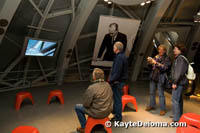 Three of the spheres below have exhibit space. A permanent exhibit features giant photos of some of the key players in the construction and a great 12 minute silent video documenting the construction of the Atomium. The other two areas have changing exhibits.
Three of the spheres below have exhibit space. A permanent exhibit features giant photos of some of the key players in the construction and a great 12 minute silent video documenting the construction of the Atomium. The other two areas have changing exhibits.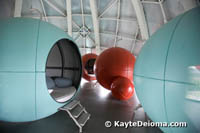 who can come and spend the night as part of an educational program. The domed upper portion of the sphere is filled with smaller turquoise and red globes suspended from the ceiling. Each one has a slice out of the side and room for several kids to crawl into the cubby hole onto the round mattress piled with pillows. Unfortunately, this room is not open to the public, so you can only look through the window.
who can come and spend the night as part of an educational program. The domed upper portion of the sphere is filled with smaller turquoise and red globes suspended from the ceiling. Each one has a slice out of the side and room for several kids to crawl into the cubby hole onto the round mattress piled with pillows. Unfortunately, this room is not open to the public, so you can only look through the window. There’s something irresistible about a city as devoted to comic strips as Brussels. There are no less than four museums devoted to the history, the creators and the production of the bande dessinée or comic strip. There are over a dozen stores specializing in comic books and merchandise, and even a comic-themed bar. As if that weren’t enough, you can see larger than life comic statues and murals of some of the most popular characters all around town.
There’s something irresistible about a city as devoted to comic strips as Brussels. There are no less than four museums devoted to the history, the creators and the production of the bande dessinée or comic strip. There are over a dozen stores specializing in comic books and merchandise, and even a comic-themed bar. As if that weren’t enough, you can see larger than life comic statues and murals of some of the most popular characters all around town. It’s not the American classics like Peanuts and Superman, or Japanese animé, but home-grown creations like Tintin, the Smurfs and hundreds of others that have filled the pages of Belgian newspapers, magazines and comic books for a century. Belgium, as it turns out, has more comic strip authors per square mile than anywhere else in the world.
It’s not the American classics like Peanuts and Superman, or Japanese animé, but home-grown creations like Tintin, the Smurfs and hundreds of others that have filled the pages of Belgian newspapers, magazines and comic books for a century. Belgium, as it turns out, has more comic strip authors per square mile than anywhere else in the world. The strategically placed comic strip characters look a bit out of place in the elegant lobby with its stone columns and wrought iron grillwork supporting a frosted glass ceiling embellished with stained glass ribbons around the edges. Through an opening in the center you can see the upper floors and skylight above. Along with the restaurant and Art Nouveau gallery, a gift shop, reading room and research center surround the atrium. A marble-based lamp post stands in the center, and a wide stairway leads up to the ticket desk and official entrance to the museum.
The strategically placed comic strip characters look a bit out of place in the elegant lobby with its stone columns and wrought iron grillwork supporting a frosted glass ceiling embellished with stained glass ribbons around the edges. Through an opening in the center you can see the upper floors and skylight above. Along with the restaurant and Art Nouveau gallery, a gift shop, reading room and research center surround the atrium. A marble-based lamp post stands in the center, and a wide stairway leads up to the ticket desk and official entrance to the museum. The first hall behind the ticket counter introduces you to the original technologies used to create and print comic strips as well as the team of writers, artists, colorists, letterers and printers whose efforts go into producing the final product. Publishers, marketers and merchandisers have their roles as well.
The first hall behind the ticket counter introduces you to the original technologies used to create and print comic strips as well as the team of writers, artists, colorists, letterers and printers whose efforts go into producing the final product. Publishers, marketers and merchandisers have their roles as well. In the Espace Saint Roche gallery, the museum presents rotating exhibits from their collection of over 7,000 original comic strip drawings. On the opposite side, Comic Strips in Motion shows the evolution from comic strips to animated cartoons from Little Nemo, the first animated cartoon in 1911, to modern digital animation technology.
In the Espace Saint Roche gallery, the museum presents rotating exhibits from their collection of over 7,000 original comic strip drawings. On the opposite side, Comic Strips in Motion shows the evolution from comic strips to animated cartoons from Little Nemo, the first animated cartoon in 1911, to modern digital animation technology. The Smurf Museum exhibit tells the tale of the “intrepid Professor De Saeger” who found the mystical land of the little blue “Schtroumphs” and brought back these artifacts to prove their existence. The display includes original line drawings and paints and well as Smurf toys and a “scale model of a Smurf dwelling.”
The Smurf Museum exhibit tells the tale of the “intrepid Professor De Saeger” who found the mystical land of the little blue “Schtroumphs” and brought back these artifacts to prove their existence. The display includes original line drawings and paints and well as Smurf toys and a “scale model of a Smurf dwelling.” The printed English guide is invaluable for understanding the significance of the permanent collection if you don’t read French or Dutch. If you want to get the most out of the museum but you don’t want to do all that reading, you might want to hire an English-speaking guide. They are available by appointment only and charge a flat rate for up to 25 people for a one and a half hour tour. Guides are also available to take you on a walking tour of the outdoor Comic Strip Trail.
The printed English guide is invaluable for understanding the significance of the permanent collection if you don’t read French or Dutch. If you want to get the most out of the museum but you don’t want to do all that reading, you might want to hire an English-speaking guide. They are available by appointment only and charge a flat rate for up to 25 people for a one and a half hour tour. Guides are also available to take you on a walking tour of the outdoor Comic Strip Trail.